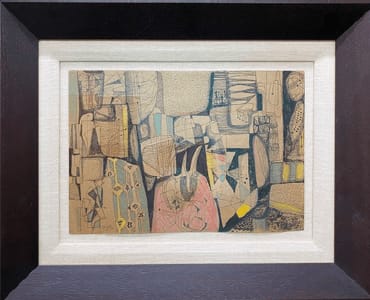Roberto Juan Diago Querol
Obras
-

-
 Roberto Juan Diago QuerolUntitled , N.D.Untitled , N.D.
Roberto Juan Diago QuerolUntitled , N.D.Untitled , N.D.
Ink and Gouache on paper
26 x 39.4 cm
10 1/4 x 15 1/2 inmore -

-
 Roberto Juan Diago QuerolYari – Yari Mama Olua, 19415 water colour paintings on paper
Roberto Juan Diago QuerolYari – Yari Mama Olua, 19415 water colour paintings on paper
25 x 37 cm each
5 Works on PaperSet of 5 Water Colour Sketchesmore -
 Roberto Juan Diago QuerolStudy for “La Noche”, 1945Mixed media on paper207.7 x 45.7 cm
Roberto Juan Diago QuerolStudy for “La Noche”, 1945Mixed media on paper207.7 x 45.7 cm
81 3/4 x 18 inmore -
 Roberto Juan Diago Querol“Mujer” (Woman), 1948Oil on cardboard70.3 x 55.6 cm
Roberto Juan Diago Querol“Mujer” (Woman), 1948Oil on cardboard70.3 x 55.6 cm
27 5/8 x 21 7/8 inmore -

-

-
 Roberto Juan Diago QuerolUntitled (Figures in red, black and green), 1953Gouache, acrylic, and ink on paper
Roberto Juan Diago QuerolUntitled (Figures in red, black and green), 1953Gouache, acrylic, and ink on paper
31 x 25 cm
12 1/4 x 9 7/8 inmore -
 Roberto Juan Diago QuerolUntitled (Face in red, blue and ochre), 1953Pastel on cardboard
Roberto Juan Diago QuerolUntitled (Face in red, blue and ochre), 1953Pastel on cardboard
42 x 52 cm
16 1/2 x 20 1/2 inmore -

-

Biografía
Roberto Diago (1920–1955) was a Cuban painter and educator whose work helped shape mid-20th century Cuban modernism. Born in Havana, he trained at the San Alejandro National Academy of Fine Arts, earning his diploma in 1942. Diago later taught at the Tarascó School of Plastic Arts in Matanzas, where he worked alongside artist Rafael Soriano. Known for his expressive use of color and form, Diago’s practice bridged academic rigor and personal experimentation. He died under mysterious circumstances in Madrid in 1955. His work is held in major institutions, including the Museum of Modern Art (MoMA) and the Museo Nacional de Bellas Artes, Havana.












